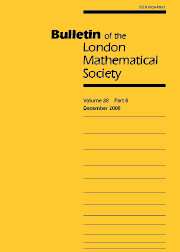Crossref Citations
This article has been cited by the following publications. This list is generated based on data provided by
Crossref.
Eyral, Christophe
2006.
Zariski's multiplicity question and aligned singularities.
Comptes Rendus. Mathématique,
Vol. 342,
Issue. 3,
p.
183.
Xu, Xu
2007.
On the Multiplicity of a C ∞–differentiable Function–germ.
Acta Mathematica Sinica, English Series,
Vol. 23,
Issue. 4,
p.
711.
KOIKE, Satoshi
and
PARUSIŃSKI, Adam
2013.
Equivalence relations for two variable real analytic function germs.
Journal of the Mathematical Society of Japan,
Vol. 65,
Issue. 1,
Teymuri Garakani, Mahdi
2014.
A note on the Zariski multiplicity conjecture.
Comptes Rendus. Mathématique,
Vol. 352,
Issue. 9,
p.
725.
Hà, H.V.
Ngãi, H.V.
and
Phạm, T.S.
2015.
A global smooth version of the classical Łojasiewicz inequality.
Journal of Mathematical Analysis and Applications,
Vol. 421,
Issue. 2,
p.
1559.
Rosas, Rudy
2016.
Bilipschitz Invariants for Germs of Holomorphic Foliations.
International Mathematics Research Notices,
Vol. 2016,
Issue. 11,
p.
3425.
Bivià-Ausina, Carles
and
Fukui, Toshizumi
2017.
Invariants for bi-Lipschitz equivalence of ideals.
The Quarterly Journal of Mathematics,
Vol. 68,
Issue. 3,
p.
791.
Farnik, M.
Jelonek, Z.
and
Migus, P.
2018.
On quadratic polynomial mappings from the plane into the n dimensional space.
Linear Algebra and its Applications,
Vol. 554,
Issue. ,
p.
249.
Feehan, Paul
2019.
Resolution of singularities and geometric proofs
of the Łojasiewicz inequalities.
Geometry & Topology,
Vol. 23,
Issue. 7,
p.
3273.
Nguyen, Hong-Duc
Phạm, Tien-Son
and
Hoàng, Phi-Dũng
2019.
Topological invariants of plane curve singularities: Polar quotients and Łojasiewicz gradient exponents.
International Journal of Mathematics,
Vol. 30,
Issue. 14,
p.
1950073.
Ruas, Maria Aparecida Soares
2020.
Introduction to Lipschitz Geometry of Singularities.
Vol. 2280,
Issue. ,
p.
111.
Lê, Công Trình
and
Lương, Việt Chương
2020.
On Tangent Cones of Analytic Sets and $$\L $$ojasiewicz Exponents.
Bulletin of the Iranian Mathematical Society,
Vol. 46,
Issue. 2,
p.
355.
Nguyen, Nhan
Ruas, Maria
and
Trivedi, Saurabh
2020.
Classification of Lipschitz simple function germs.
Proceedings of the London Mathematical Society,
Vol. 121,
Issue. 1,
p.
51.
Trotman, David
2020.
Introduction to Lipschitz Geometry of Singularities.
Vol. 2280,
Issue. ,
p.
87.
Bobadilla, Javier Fernández de
2022.
Handbook of Geometry and Topology of Singularities III.
p.
145.
Fernandes, Alexandre
and
Sampaio, José Edson
2023.
Handbook of Geometry and Topology of Singularities IV.
p.
463.

